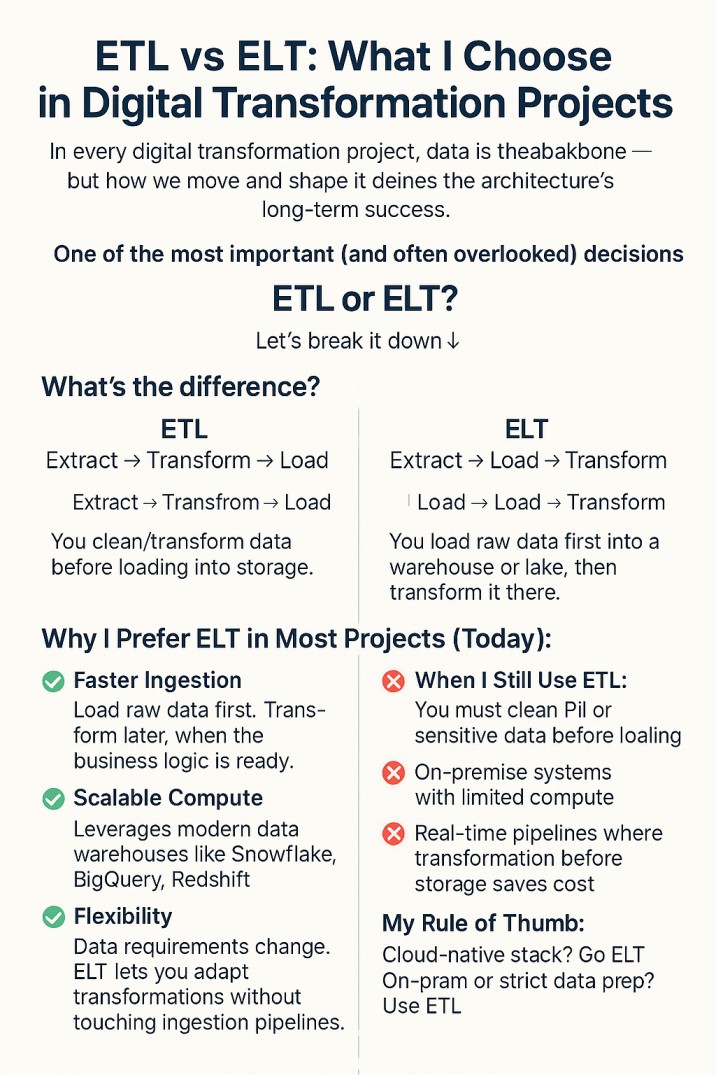In every digital transformation project, data is the backbone — but how we move, transform, and manage that data shapes the long-term success of the architecture.
One of the most critical and often overlooked decisions early in any project is:
Should we use ETL or ELT?
Let’s break down the difference, and why I increasingly lean toward ELT in modern transformation initiatives.
Understanding ETL vs ELT
At first glance, these two approaches might seem like minor variations. But the order of operations creates very different implications for system design, scalability, and agility.
ETL: Extract → Transform → Load
- Data is extracted from source systems
- Transformed in an external processing layer or ETL tool
- Then loaded into the target system, often a structured data warehouse
ELT: Extract → Load → Transform
- Raw data is extracted and loaded directly into the data warehouse or lake
- Then transformed within the target system using its compute engine
Why I Prefer ELT in Most Projects Today
As cloud-native architectures become the norm, ELT offers significant advantages for digital transformation programs:
1. Faster Data Ingestion
You can load raw data immediately without waiting for business rules or transformation logic to be finalized. This allows for early exploration and faster iteration.
2. Scalable Compute
Cloud platforms like Snowflake, BigQuery, Redshift, and Databricks are optimized to handle massive transformation workloads. ELT leverages these capabilities rather than relying on limited external ETL tools.
3. Greater Flexibility
Business requirements change often. With ELT, you can adjust or re-run transformations without disrupting the ingestion process or reconfiguring pipelines.
4. Improved Data Lineage and Governance
Modern tools like dbt, Airflow, and OpenLineage allow transformations to be version-controlled, auditable, and transparent — making it easier to ensure compliance and traceability.
When I Still Use ETL
That said, ETL still plays a role in certain contexts:
- When sensitive or regulated data (e.g., PII) needs to be anonymized or cleaned before entering storage
- In on-premise environments where the target systems lack transformation compute
- For real-time ingestion pipelines, where transforming before loading reduces storage or processing costs
My Rule of Thumb
If you’re building on a cloud-native stack:
→ Go ELT — leverage scalable compute, simplify your pipelines, and iterate faster.
If you’re working with on-prem systems or need pre-ingestion transformations for compliance or real-time use cases:
→ Use ETL — it offers more control before storage.
Final Thoughts
The choice between ETL and ELT is not just a technical detail — it’s a strategic architectural decision that affects data availability, governance, scalability, and agility.
Digital transformation isn’t about copying the latest patterns — it’s about making contextual, forward-looking decisions that suit your business, your stack, and your future needs.
Make your data flow decisions early.
They define everything downstream — from analytics to automation to AI readiness.
What approach are you using in your projects — ETL, ELT, or a hybrid of both?
I’d love to hear your thoughts and experiences.

